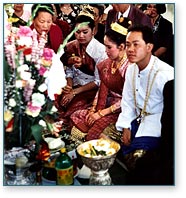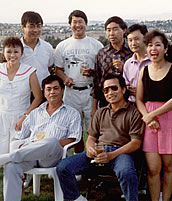Continued from page 1
Marriage
Although most children are now allowed to select their own partners, some parents still attempt to set their children up in arranged marriages. Dating and public displays of affection have been new concepts for many first-generation parents. Some ethnic groups still practice elaborate marriage traditions, including the dowry system, in which a marriage negotiator arranges for the groom’s family to pay  the bride’s family in order to bind the groom’s commitment and to help organize the wedding plans. The Hmong have had to adjust marriage practices that are not culturally acceptable in the United States, such as polygamy and kidnap marriages of girls in their early teens. Some Southeast Asian American parents may exert direct or indirect pressure on their children to select certain spouses. They often want their children to marry co-ethnics who they feel are more likely to share the same language, culture, ad religion. the bride’s family in order to bind the groom’s commitment and to help organize the wedding plans. The Hmong have had to adjust marriage practices that are not culturally acceptable in the United States, such as polygamy and kidnap marriages of girls in their early teens. Some Southeast Asian American parents may exert direct or indirect pressure on their children to select certain spouses. They often want their children to marry co-ethnics who they feel are more likely to share the same language, culture, ad religion.
Lesbian, gay, bisexual, and trans-gendered Southeast Asian Americans feel pressure from their parents to adhere to traditional marriages and have countered this by asserting their own identity and forming support groups. Both straight and gay Southeast Asian Americans are choosing partners from other Asian ethnic groups and other racial groups. Some males return to their homeland to find brides who they feel are more traditional than the women they find in the United States. Teenage pregnancy rates are low, yet there is a growing number of single young women having children.
New Roles for Women
Females are still expected to play the traditional roles of wives and mothers and to consider their own employment outside the household as secondary to their husbands’ jobs. Some are pursuing full-time careers and delaying marriage, however, as well as choosing to have fewer children than their parents’ generation or deciding not to have children at all. Some men, who were accustomed to being in authority  positions in their families and in their previous status as soldiers or leaders have had difficulty adjusting to these new gender roles. This is especially true for those who have been unable to find adequate employment and whose wives have become the primary wage earners. positions in their families and in their previous status as soldiers or leaders have had difficulty adjusting to these new gender roles. This is especially true for those who have been unable to find adequate employment and whose wives have become the primary wage earners.
Disproportionate numbers of men and boys were killed during the war, so many women have become the sole providers and decision-makers for their family, which also changes gender dynamics. Divorce rates are still relatively low statistically, but divorce is gradually becoming more commonplace. Also, statistics do not represent the number of married couples who live apart or unmarried couples who live together. Although groups may maintain traditional family values on the surface, reinforced by their religious beliefs, the community seems more accepting of varying family arrangements, acknowledging the impact of the war and displacement on relationships.
|


 the bride’s family in order to bind the groom’s commitment and to help organize the wedding plans. The Hmong have had to adjust marriage practices that are not culturally acceptable in the United States, such as polygamy and kidnap marriages of girls in their early teens. Some Southeast Asian American parents may exert direct or indirect pressure on their children to select certain spouses. They often want their children to marry co-ethnics who they feel are more likely to share the same language, culture, ad religion.
the bride’s family in order to bind the groom’s commitment and to help organize the wedding plans. The Hmong have had to adjust marriage practices that are not culturally acceptable in the United States, such as polygamy and kidnap marriages of girls in their early teens. Some Southeast Asian American parents may exert direct or indirect pressure on their children to select certain spouses. They often want their children to marry co-ethnics who they feel are more likely to share the same language, culture, ad religion.  positions in their families and in their previous status as soldiers or leaders have had difficulty adjusting to these new gender roles. This is especially true for those who have been unable to find adequate employment and whose wives have become the primary wage earners.
positions in their families and in their previous status as soldiers or leaders have had difficulty adjusting to these new gender roles. This is especially true for those who have been unable to find adequate employment and whose wives have become the primary wage earners.